Asa Briggs 1832 - 1912
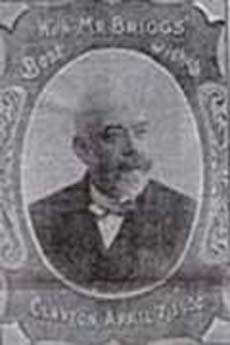
A well known and respected Claytonian, he was born in the township and played an important part in the life of the village. It was said that he was a generous supporter of every movement that had for its objective the religious, social and general well being of the masses. He also played a prominent part in the industrial expansion of the village, being a partner in the worsted manufacturing business of Joseph Benn & Co. He was chair of the Local Board and continued as chairman of the District Council following its formation in 1894. A staunch Baptist he was also chair of the school board,a J.P. and played an important part in the development and opening of Victoria Park in 1898. He lived at Greenside House, Clayton Lane and played an important role in the development of the Liberal Club now the Village Hall. Asa Briggs was the owner of a great deal of property and was very wealthy, a great philanthropist he gave generously to the residents of Clayton and Clayton Heights where a park was created and named after him.
Sherwin Stephenson 1881 - 1954
The Clayton Poet
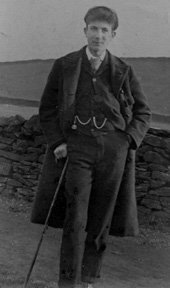
The family was quite poor but the children were well cared for. His mother was a weaver and his father a doffer and Sherwin spent much of his time with his grandparents. In 1953 he wrote that he had always been grateful for the simple home truths that they taught him. Sherwin started school at Clayton Infants School at 3 years old, at 7 years he was in standard 1 and was later to describe his education as "plain and hard but happy". He was sorry to have to leave school at 13 to work full time at the mill as the family needed the money. However, determined to learn all he could he attended night school 3 nights a week and became a talented writer of poetry, describing in verse many of his experiences of life and things he saw as he grew up in and around Clayton. He also wrote a poem about Clayton Parish Church where he had sung as a choir boy. Those were happy days for him, the highlight of the year being the choir trip and annual carol singing, finishing at the home of Colonal Hirst with a feast. He wrote a special poem to celebrate the church centenery in 1951 and also poems about his family, including his son Maurice who was killed in action in March 1942. Sherwin was for many years the manager of Bradford Road Co-op. He died in 1954 and is buried in Clayton Parish Church yard, where his memorial is in the shape of an open book.
GURT REWTH
A POEM BY SHERWIN
A, angel she i, clogs an, shawl,
An, luved bi t,poor fowks mooast ov all;
Hah t,poorly fowkes did her to cling,
She mothers helped ther bairns ta bring
Ta deein fowk she whispered cheer,
An, laid ,em aght wi, a silent tear,
Oh! she were a gooid un wor Gurt Rewth,
A-body knows Ah,m speikin, t,trewth
She hed nooa halo an, no wings,
Like artists gie ta,em wat hings,
I,fancy frames on t,cottage walls,
An, finn,d a hooam wi, t,rich an, all;
Now nooan sooa fer Rewth wor plain,
She did,t moiter ner complain;
She wor as God wod hev her be,
An angel i,reality.
Sherwin 1941
From Musings of Field and Hearth In Verse
|
Alfred Wallis
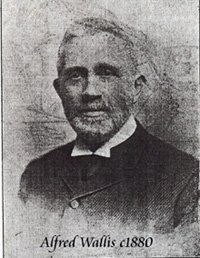
Alfred Wallis 1829 - 1913
A well known and highly respected Claytonian, Alfred Wallis started in business in 1860 at Brow Mill with Joseph Benn and Asa Briggs.
He was very active in public affairs, an overseer for 29 years, County Councillor for Clayton, Thornton and Denholme, and generally taking a close interest in the welfare of Clayton residents.
In 1898 Alfred became the sole owner of Oak Mills with his sons Frank and Joah, he also owned Highgate Farm
He lived at " Glenholme" in Pasture Lane and set up the Alfred Wallis Trust Fund.
|
Julius Whitehead
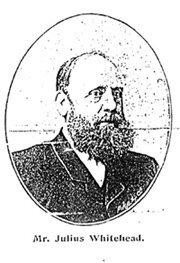
Julius Whitehead 1839 - 1908
Julius Whithead came to Clayton in 1880, having served his apprenticeship with the Farnley Iron Company, and later being in business on his own account in Halifax.
He was very inventive and designed and patented the Acme Multiple Pipe Making machine.
He started up business in Clayton as Julius Whithead Fire Clay works at the bottom of Brow Lane. He took an interest in the life of the village and was involved in the opening of Victoria Park. He was chairman of the proceedings and presented Asa Briggs with a gold key with which to open the gates.
|
|
|
Henry Sagar Hirst

Henry Sagar Hirst 1829 - 1899
A very prominent member of the Hirst family.
He was born on the 5th October 1829 and baptised at Thornton Bell Chapel. He was the third son of Thomas and Sarah Hirst of Low House, Clayton Heights.
He was privately educated and trained to be a solicitor.
His father died when he was 10 years old.
At the age of 21, he joined his elder brother Joseph, who had started a brewing business at Low House and from 1851 they traded as Messrs J & H.S.Hirst.
In 1861 Henry built a large house next to Low House and called it Westwood House.
Three years later he married Sarah Foster, eldest daughter of John Foster of Hornby Castle, the founder of Black Dyke Mills.
As a young man he joined the Volunteer Movement as an Ensign.
After just three years he was appointed Lieutenant Colonel commanding the 3rd West Yorkshire Rifle Engineers (The Bradford Rifles). He resigned his commission in 1890, when he was aged sixty. He was made Honorary Colonal of the Battalion.
In 1881 he received the title "Companion of the Bath" for his services to the volunteer movement. A portrait of him (by John Snowden), wearing his insignia is in the Bolling Hall Museum.
He was President of The West Riding Rifle Association, Master of Clayton Harriers and Captain of the Bradford Cricket Team.
In Clayton he was church warden for 47 years, manager of The National School and President of the local Conservative Club.
He was a trustee of "The Sagar Charity", which had been founded by James Sagar, a direct ancester from the 17th century.
After retiring from business in 1880, he became a local Magistrate.
In 1897 he had a stroke and died on the 8th May 1899.
He died childless, but by all accounts he was kept fully occupied.
The Low House Brewery was later sold to Bentley's Brewery and Westwood House was puchased by Bradford Council for use as a hospital.
He is buried in the parish church yard and there is a memorial inside the church.
|
|
Thomas and John Hirst of Clayton House
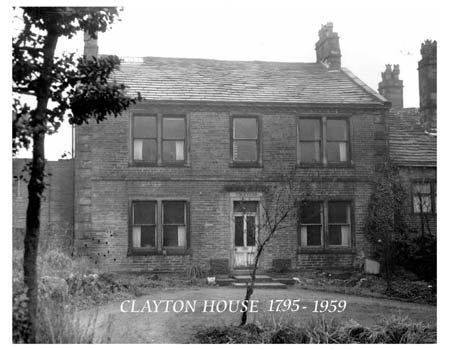
| |
|
Thomas Hirst 1763 - 1801
The Hirst family are said to have come to Bradford from Batley in 1618.
They puchased an estate called Brightwaters in1628, which was situated on land to the south of Clayton Heights and here the family settled for many years.
Thomas Hirst was born 1763 and in 1790 married Elizabeth Sagar.
In 1795 Thomas built Clayton House on land in the area of what is today Whittle Crescent, he built a large wing to his house for his staff.
Thomas was a farmer and his farm and maltkiln were adjacent to the impressive Georgian house.
William Cudworth wrote in 1876 that they were the "principle residential family of Clayton".
In his heyday he weighed thirty stone, he was an overseer of the highways and a parish warden of Thornton Chapel. When Clayton first became a parish, services were held at the maltkiln.
He died in 1801 and was buried beneath Thornton Bell Chapel. When Clayton Parish Church was opened in 1851, his body was exhumed and carried over to Clayton by his old servants and reburied in the church grounds, the first person to be buried there.
John Hirst 1793 - 1852
John Hirst, son of Thomas was born in 1793. He married Mary Baines of Spofforth in May 1815.
He was a farmer and maltster and owned the Black Bull public house. They had several children, Robert Baines Hirst b1830, John b1832, Henry b 1836, Anna b1821, Frances b1833, Eliza b1826, Maria b1826 and Sarah b1827.
The house was inherited by Robert Baines Hirst after his father died in 1852.
It was John Hirst who donated the land on which Clayton Parish Church would be built. Sadly he died only one year after after the church was opened.
The impressive Hirst memorial stone is in Clayton Church yard.
|
|
|
The Hirsts of Low House
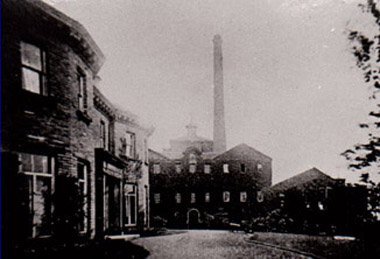
| |
|
LOW HOUSE and BREWERY c1910
Arthur Hirst died in1672. His son John bought Low House in 1665 from the trustee's of his father in law, Abraham Brathwaite.
It was said that Low House, then known as "Brightwaters" and was situated near Stocks Lane Bottom, near the Clayton/Shelf parish boundary, was where the worsted trade of Clayton had its origins. Yarn was spun and made into pieces on hand looms, on premises adjoining Low House.
John and his wife Susannah had nine children. Their second son Thomas, inherited Low House in 1715, and married Mary Hodgson of Fairweather Green about the same time. Their second son also called Thomas inherited the property in 1789.
Thomas had previously procured a licence to open a public house "The Dolphin" (later known as The Old Dolphin).
In 1762 he married Betty Hopkin, the widow of Daniel Hopkin the previous landlord.
Joseph Hopkin Hirst their son married Alice Sagar of Allerton Grange.
Their son Thomas, married Sarah Stocks daughter of a wealthy collier.
Thomas died of liver failure aged 46 and his son Arthur (see below), went to Rotherham to manage the Bentley Brewery for his brother in law Robert John Bentley.
Arthur's brother Joseph joined Henry Sagar Hirst to form the Low House Brewery.
Joseph was the last Hirst to occupy of Low House, he died in 1890 and in 1893 his sons sold the whole estate to Bentley's Breweries.
|
|
|
Arthur Hirst of Low House
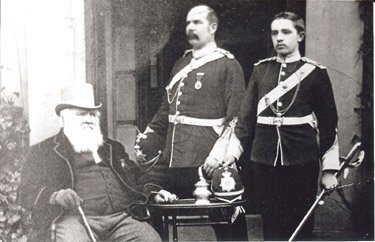
|
| |
|
Arthur Hirst, son of Thomas Hirst Of Low House, who in turn was cousin of John Hirst of Clayton House.
Arthur b1823, is shown with his son Arthur Percy and grandson Arthur Bertram.
He married into the Bentley brewery family and managed the company in Rotherham.
|
|
John Hirst
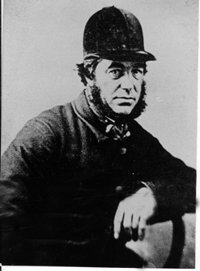
John Hirst of Hill End, Hollingwood Lane.
Known as "The Mighty Hunter" and master of the Clayton Harriers.
Further Reading The Hirst Family File C.H.G Archive
|








